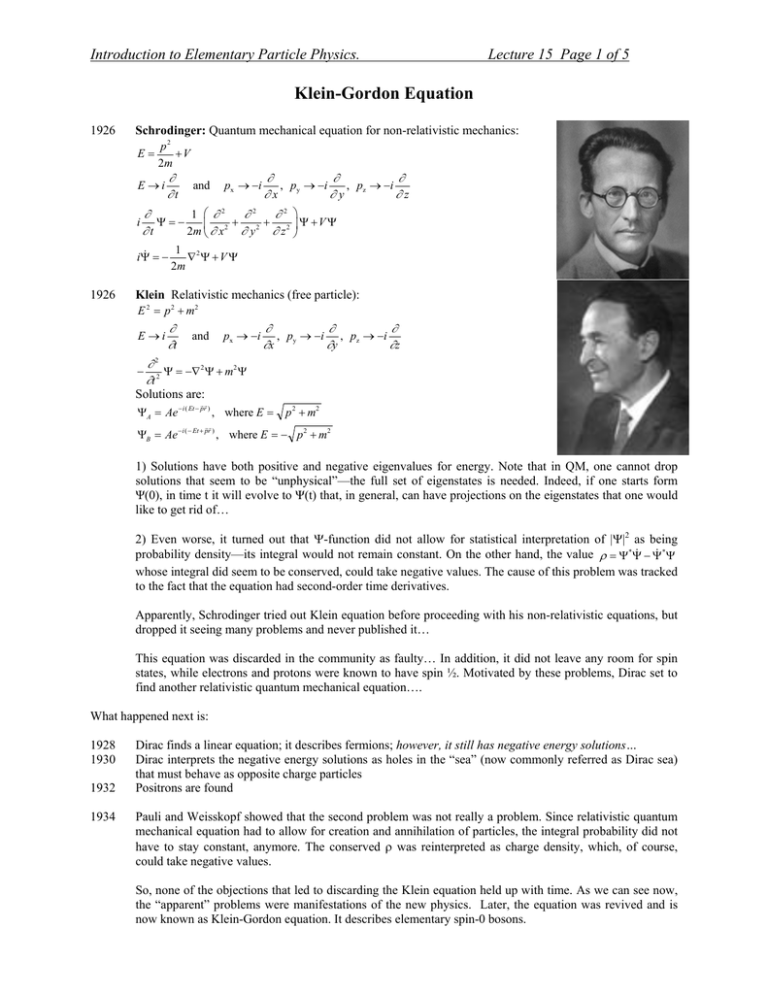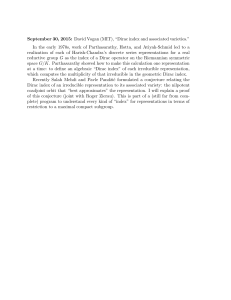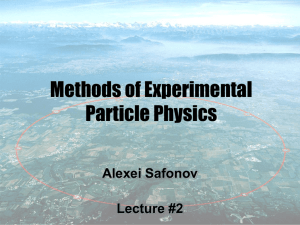Document 10582490
advertisement

Introduction to Elementary Particle Physics. Lecture 15 Page 1 of 5 Klein-Gordon Equation 1926 Schrodinger: Quantum mechanical equation for non-relativistic mechanics: E= p2 +V 2m E →i i ∂ ∂t px → −i ∂ ∂ ∂ , py → −i , pz → −i ∂x ∂y ∂z 1 ⎛ ∂2 ∂ ∂2 ∂2 ⎞ Ψ=− + 2 ⎟Ψ +V Ψ ⎜ 2+ 2 2m ⎝ ∂ x ∂ y ∂ z ⎠ ∂t =− iΨ 1926 and 1 2 ∇ Ψ +V Ψ 2m Klein Relativistic mechanics (free particle): E 2 = p 2 + m2 E →i ∂ ∂t and px → −i ∂ ∂ ∂ , py → −i , pz → −i ∂x ∂y ∂z ∂2 Ψ = −∇ 2 Ψ + m2 Ψ ∂t 2 Solutions are: − GG ΨA = Ae − i ( Et − pr ) , where E = p 2 + m2 GG ΨB = Ae − i ( − Et + pr ) , where E = − p 2 + m2 1) Solutions have both positive and negative eigenvalues for energy. Note that in QM, one cannot drop solutions that seem to be “unphysical”—the full set of eigenstates is needed. Indeed, if one starts form Ψ(0), in time t it will evolve to Ψ(t) that, in general, can have projections on the eigenstates that one would like to get rid of… 2) Even worse, it turned out that Ψ-function did not allow for statistical interpretation of |Ψ|2 as being −Ψ *Ψ probability density—its integral would not remain constant. On the other hand, the value ρ = Ψ*Ψ whose integral did seem to be conserved, could take negative values. The cause of this problem was tracked to the fact that the equation had second-order time derivatives. Apparently, Schrodinger tried out Klein equation before proceeding with his non-relativistic equations, but dropped it seeing many problems and never published it… This equation was discarded in the community as faulty… In addition, it did not leave any room for spin states, while electrons and protons were known to have spin ½. Motivated by these problems, Dirac set to find another relativistic quantum mechanical equation…. What happened next is: 1928 1930 1932 1934 Dirac finds a linear equation; it describes fermions; however, it still has negative energy solutions… Dirac interprets the negative energy solutions as holes in the “sea” (now commonly referred as Dirac sea) that must behave as opposite charge particles Positrons are found Pauli and Weisskopf showed that the second problem was not really a problem. Since relativistic quantum mechanical equation had to allow for creation and annihilation of particles, the integral probability did not have to stay constant, anymore. The conserved ρ was reinterpreted as charge density, which, of course, could take negative values. So, none of the objections that led to discarding the Klein equation held up with time. As we can see now, the “apparent” problems were manifestations of the new physics. Later, the equation was revived and is now known as Klein-Gordon equation. It describes elementary spin-0 bosons. Introduction to Elementary Particle Physics. Lecture 15 Page 2 of 5 Dirac Equation 1928 Dirac: searches for an alternative relativistic equation starting from the generic form describing evolution of wave function: ∂ i Ψ = H Ψ ∂t If one keeps first order derivative of time, then to preserve Lorentz invariance, the space coordinate derivatives must be of the first order as well. Having all energy-related operators (E, p, m) of the same first order: ∂ ∂ ∂ ∂ and pˆ x = −i , pˆ y = −i , pˆ z = −i Eˆ = i ∂z ∂t ∂x ∂y Eˆ Ψ = (α1 pˆ x + α 2 pˆ y + α 3 pˆ z + βm )Ψ By acting with left- and right-hand operators twice, we get 2 Eˆ 2 Ψ = (α1 pˆ x + α 2 pˆ y + α 3 pˆ z + βm ) Ψ which must be compatible with the Klein-Gordon equation: ( ) Eˆ 2 Ψ = pˆ x2 + pˆ y2 + pˆ z2 + m 2 Ψ This implies that: α iα j + α jα i = 0, for i ≠ j α i β + βα i = 0 α i2 = 1 β2 = 1 Therefore, parameters α and β cannot be numbers. However, it may and does work if they are matrices, the lowest order being 4×4. Therefore, ψ must be 4-component vectors. Popular representations are ⎛ 0 σi ⎞ ⎛1 0 ⎞ ⎟⎟ and β = ⎜⎜ ⎟⎟ α i = ⎜⎜ ⎝ 0 − 1⎠ ⎝σ i 0 ⎠ where σ i are 2 × 2 Pauli matrices : ⎛0 1⎞ ⎛0 − i⎞ ⎛1 0 ⎞ ⎟⎟ σ 2 = ⎜⎜ ⎟⎟ σ 3 = ⎜⎜ ⎟⎟ ⎝1 0⎠ ⎝i 0 ⎠ ⎝ 0 − 1⎠ σ 1 = ⎜⎜ The equation is usually written using γμ-matrices, where γi=βαi for i=1,2,3 and γ0=β (just multiply the above equation with matrix β and move all terms on one side of the equation): ⎛ ⎞ ⎛ 0 σi ⎞ ⎛1 0 ⎞ ∂ − m ⎟ Ψ = 0 where γ i = ⎜ ⎜⎜ iγ μ ⎟ and γ 0 = ⎜ ⎟ ⎟ σ 0 − ∂ x ⎝ 0 −1⎠ ⎝ i ⎠ μ ⎝ ⎠ Find solution for particles at rest, i.e. p=0: ⎛ψ 1 ⎞ ⎜ ⎟ ∂ ⎛ ⎞ ⎜ψ 2 ⎟ − γ i m ⎜ 0 ⎟ ⎜ψ ⎟ = 0 ⎝ ∂t ⎠ 3 ⎜ ⎟ ⎝ψ 4 ⎠ ⎛ΨA ⎞ ∂ ⎛1 0 ⎞⎛ ΨA ⎞ ⎜ ⎟ = m⎜ ⎟ ∂ t ⎜⎝ 0 −1⎟⎠ ⎝ Ψ B ⎠ ⎝ ΨB ⎠ It has two positive energy solutions that correspond to two spin states of spin-½ electrons: i ⎛1⎞ ΨA = e− imt ⎜⎜ ⎟⎟ ⎝ 0⎠ ⎛0⎞ and ΨA = e − imt ⎜⎜ ⎟⎟ ⎝1⎠ and two symmetrical negative-energy solutions ⎛1⎞ ΨB = e+ imt ⎜⎜ ⎟⎟ ⎝0⎠ ⎛ 0⎞ and ΨB = e+ imt ⎜⎜ ⎟⎟ ⎝1⎠ Introduction to Elementary Particle Physics. 1930 Lecture 15 Page 3 of 5 Dirac’s interpretation of the negative energy solution If negative energy states do exist, one had to explain why electrons did not fall down to lower energy levels. To handle this problem, Dirac appealed to the fact that electrons are fermions and no two electrons could take the same quantum state (the Pauli Exclusion Principle). Therefore, Dirac argued, there would be no problem if one could imagine that all the negative energy states were already filled with electrons, forming a so-called Dirac sea of electrons with negative energies. Then electrons with positive energy would not be able to fall down to the lower level energy levels. Since these negative energy levels were inaccessible to the few “real” electrons, the existence of such sea would not be observable… However, Dirac himself soon noticed that there would be at least one observable manifestation of such sea. One could excite an electron from the negative energy state to the positive level by transferring it enough energy, minimum being about 1 MeV (two masses of an electron). A resulting hole created in the negative energy sea, which is merely an absence of negative charge, would appear to be a positively charged particle. At the time when Dirac invented his equation the electron and proton were assumed to be the only two subatomic particles (neutron was not discovered at that time). Dirac therefore assumed that this positive particle, produced by an electron leaving the sea of negative energy states, would be a proton. There was a problem with this theory however. Several physicists showed that the hole in the Dirac sea would have to behave as a particle with the same mass as an electron and the proton of course was much too heavy… Is it possible then that there could be another positively charged particle of electron mass? No one dared at that time to suggest such a bold idea … All one would naively need is to hit sufficiently hard the sea (vacuum) with the energy >1 MeV. Annihilation of an electron with a hole would also be possible with emitting photons in the same way as transitions between energy levels in atoms. Another formal interpretation of the negative energy solutions: they look like particles with positive energy, but moving backward in time… All these interpretations are awkward and not easy to handle. Moreover, the idea of the idea of the Dirac sea not work for bosons at all even at this superficial level. The final formalism of dealing with the relativistic quantum equations has been developed since that time and is now called the Quantum Field Theory. The solutions for particles with negative energies are reinterpreted as anti-particles with positive energy… All the “truly” elementary particles and “fundamental” forces as we know them now fall into three categories: Spin-0 particles: Klein-Gordon equations Spin-½ particles: Dirac equations Spin-1 particles: Proca equations The Dirac equation predicts that the electron magnetic moment and its spin are related as μ=2μBS, while for normal orbital motion μ=μBL. Detailed calculations give small corrections to the factor g=2 and its precise measurements/calculations agree with each other at the level of ~10-11—a spectacular confirmation of the physics standing behind the Dirac equation. 1933 Dirac receives the Nobel Prize (together with Schrodinger) Introduction to Elementary Particle Physics. Lecture 15 Page 4 of 5 Discovery of positron 1932 Carl D. Anderson (Caltech) found evidence for an electron with a positive charge, or positron. Anderson discovered the positron while using a cloud chamber to investigate cosmic rays. Anderson's first picture of a positron track The positron goes upwards and loses some energy as it passes through a lead plate in the middle of the chamber. Its track is curved because there is a magnetic field in the chamber. The fact that it is curved more in the upper half tells that its momentum is smaller there and therefore it travels upward. 1933 This work was continued in the Cavendish Lab by Patrick Blackett and Guiseppe P.S. Occhialini who showed that a positron was produced together with an electron, in line with an earlier theory of Paul Dirac's. According to this theory, a positron was a hole in a sea of ordinary electrons. The positron was the antimatter equivalent to the electron. As the appearance of cosmic rays is unpredictable it was standard practice to set up the chamber to take a photograph every 15 seconds, producing a vast amount of worthless material for analysis. To avoid this Blackett introduced in 1932 the counter-controlled chamber. Geiger counters were arranged above and below the chamber that when a cosmic ray passed through both, it activated the expansion of the chamber and photographing the ion tracks produced by the ray. Using this device they confirmed in Carl Anderson's discovery of the positron. They also suggested that the positron was produced by the interaction of gamma rays with matter, in which a photon is converted into an electron-positron pair. The phenomenon is known as pair production. 1936 Anderson, at age 31, became the second youngest Nobel laureate “for his discovery of antimatter when he observed positrons in a cloud chamber”. 1948 Blackett wins Nobel Prize “for his development of the Wilson cloud chamber method and his discoveries therewith in the field of nuclear physics and cosmic radiation”. Introduction to Elementary Particle Physics. Lecture 15 Page 5 of 5 Discovery of antiproton 1955 Berkley Bevatron (6 GeV protons) Emilio Segrè, Owen Chamberlain 1959 Nobel Prize "for their discovery of the antiproton" • • • • • build a beam line for 1.19 GeV/c momentum select negatively charged particles (mostly π–) reject fast π– by Čerenkov effect: light emission in transparent medium if particle velocity v > c / n (n: refraction index) – antiprotons have v < c / n no Čerenkov light measure time of flight between counters S1 and S2 (12 m path): 40 ns for π– , 51 ns for antiprotons






